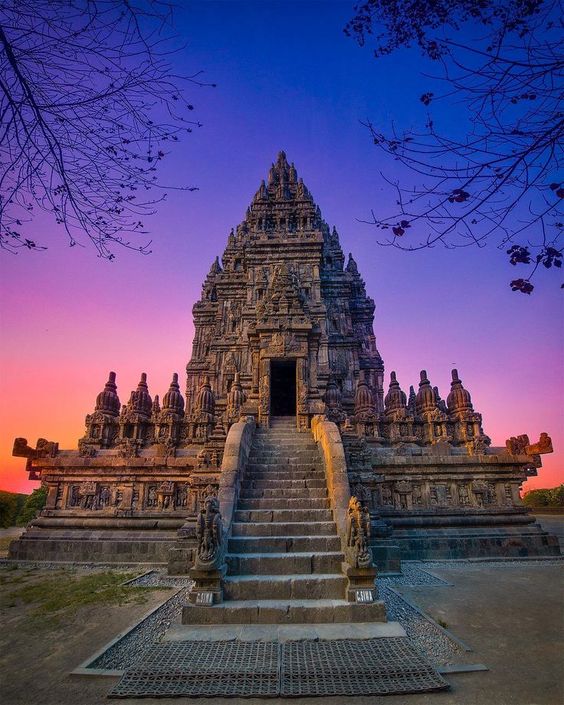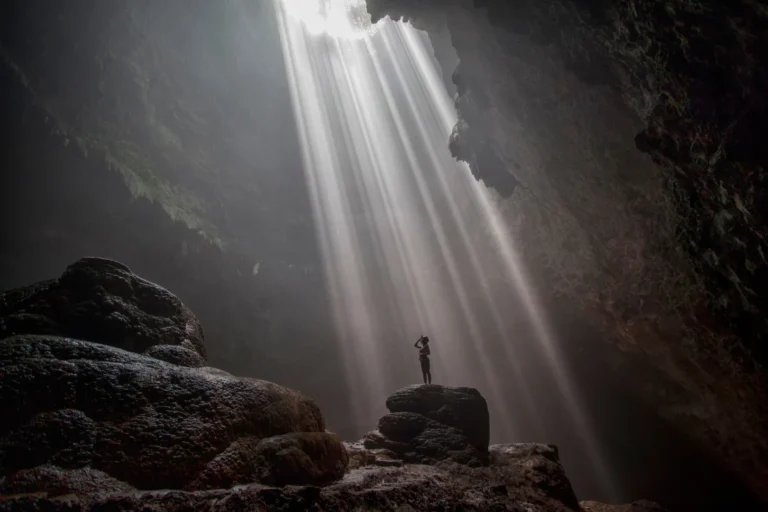Yogyakarta, often referred to as “Jogja”, is a city in Indonesia that is not only famous for its stunning natural beauty but also its rich cultural heritage. This city, located in the heart of Java Island, is a combination of local wisdom, unique traditions and rich history passed down from generation to generation. In this article, we will take you on a cultural tour of Yogyakarta, giving you insight into the local wisdom and unique traditions that make this city a gem in the heart of Indonesia.
From the splendor of its royal palaces to the intricate details of its traditional art forms, Yogyakarta is a city that always celebrates its cultural heritage. With a strong sense of community and commitment to preserving its roots, Yogyakarta offers visitors the opportunity to immerse themselves in authentic cultural experiences.
1. Borobudur Temple:

– Address: Jl. Badrawati, Borobudur, Magelang, Central Java.
– General Description: Borobudur Temple is the largest Buddhist temple in the world, consisting of thousands of reliefs and stupas. This temple offers spectacular views, especially at sunrise.
– History: Borobudur Temple is one of the most magnificent Buddhist architectural wonders in the world, located in Central Java, Indonesia. This temple is a UNESCO world heritage site and the most iconic tourist destination in Indonesia. Built in the 9th century by the Sailendra dynasty, Borobudur Temple is a stunning embodiment of Buddhist art, spirituality and history. This temple consists of thousands of reliefs and stupas which make it one of the most historic places of pilgrimage and meditation in the world.
2. Prambanan Temple:

– Address: Jl. Raya Yogya-Solo, Prambanan, Klaten, Central Java.
– General Description: Prambanan Temple is a Hindu temple complex with three magnificent main temples and beautiful reliefs.
– History: Prambanan Temple is one of the most beautiful Hindu temple sites in Indonesia and is one of the most important UNESCO world heritage sites. Located about 17 kilometers from the center of Yogyakarta, this temple is an embodiment of the magnificent architecture and grandeur of Hindu history in Central Java. Prambanan Temple is an integral part of Javanese cultural identity and is a popular tourist destination for tourists from all over the world.
Prambanan Temple, also known as Roro Jonggrang Temple, was built in the 9th century by the Ancient Mataram dynasty, especially by the kings of the Sanjaya Dynasty. This reflects the strong influence of Hinduism at that time. Devoted to the Trimurti gods (Brahma, Vishnu, and Shiva), this temple marks the glorious period of Hinduism in this region. In the following centuries, Prambanan Temple experienced difficult times, especially due to volcanic eruptions and earthquakes. Over time, this temple was abandoned and forgotten until it was rediscovered in the early 18th century by Dutch explorers.
3. Yogyakarta Palace:

– Address: Jl. Rotowijayan Block No. 1, Panembahan, Kraton, Yogyakarta City, Yogyakarta Special Region.
– Overview: Yogyakarta Palace is a royal palace that showcases Javanese art, culture and history.
– History: Yogyakarta Palace is a magnificent royal palace and center of Javanese culture located in Yogyakarta City, Yogyakarta Special Region, Indonesia. This palace is home to the Sultan of Yogyakarta and his family, and serves as a powerful symbol of Javanese culture and traditions. Founded in the 18th century, the Yogyakarta Palace is a stunning example of classic Javanese architecture. Visitors can explore the palace complex, see authentic Javanese art and culture, and learn about Yogyakarta’s proud history.
4. Taman Sari:

– Address: Taman, Panembahan, Kraton, Yogyakarta City, Yogyakarta Special Region.
– General Description: Taman Sari is a former palace complex with fountains, pools and underground caves.
– History: Taman Sari, also known as Taman Sari Water Castle, is a former palace complex located in the center of Yogyakarta City, Special Region of Yogyakarta, Indonesia. This complex includes fountains, pools and underground caves built in the 18th century by Sultan Hamengkubuwono I. Taman Sari was used as a resting and recreation place for the royal family at that time. Today, visitors can explore the site, experience its historical charm, and enjoy the charming architecture and atmosphere. Taman Sari is one of the most interesting cultural tourist destinations in Yogyakarta.
5. Parangtritis Beach:

– Address: Parangtritis Beach, District. Kretek, Bantul, Special Region of Yogyakarta.
– General Description: Parangtritis Beach is a famous beach with big waves and stunning sunset views.
– History: Parangtritis Beach is one of the most iconic beaches in Yogyakarta, Yogyakarta Special Region, Indonesia. This beach has a strong history and myth in Javanese culture.
According to folklore, Parangtritis Beach is a place believed to be the kingdom of Ratu Kidul, the ruler of the southern seas, who is believed to have supernatural powers. This beach also has a myth about Parangtritis Beach as a place to meet the nyi Loro Kidul, a mythological entity in Javanese culture who is considered the guardian of the South Coast.
The history of Parangtritis Beach includes an important role in Javanese culture, especially in spiritual and religious ceremonies. Today, this beach is a popular tourist destination offering beautiful views, strong waves, and exciting activities such as horse riding and odong-odong riding. Parangtritis Beach is the perfect combination of natural charm and deep cultural values in Yogyakarta.
6. Baron Beach:

– Address: Baron Beach, Kec. Kemadang, Gunung Kidul, Special Region of Yogyakarta.
– General Description: Baron Beach has fine white sand and an attractive local fishing atmosphere. There are several small caves that can be explored.
– History: Baron Beach is an important location for fishermen and visitors who want to enjoy the charm of Jogja’s south coast.
7. Ratu Boko Temple:

– Address: Bokoharjo Village, District. Prambanan, Sleman, Special Region of Yogyakarta.
– Overview: Ratu Boko Temple is an archaeological site with stunning sunset views.
– History: Built in the 8th century, this temple is thought to have been used as a royal complex.
8. Jomblang Cave:

– Address: Pacarejo, Semanu, Gunung Kidul, Yogyakarta Special Region.
– General Description: Jomblang Cave is an underground cave with natural light coming in through the hole in the cave roof.
– History: This cave is the result of natural geological processes formed over thousands of years.
9. Mount Merapi:

– Address: Mount Merapi, Kab. Sleman, Yogyakarta Special Region.
– Overview: Mount Merapi is an active volcano that offers thrilling hikes and lava tours.
– History: Mount Merapi is one of the most active volcanoes in Indonesia and is located in the Special Region of Yogyakarta Province. Its name, “Merapi,” literally means “Erupting Mountain” in Javanese, reflecting its constant volcanic activity. Mount Merapi has a long history of eruptions and has had a significant impact on the surrounding area.
Mount Merapi is known for its frequent eruptive activity, with records of eruptions spanning varying degrees of damage. One of the most powerful eruptions occurred in 2010, resulting in the evacuation of thousands of residents and severe damage to the surrounding area.
Javanese history and culture are closely related to Mount Merapi, which is considered a sacred mountain that has spiritual protection for the local population. Javanese people believe that Mount Merapi is the guardian and protector of the city of Yogyakarta.
Despite its potential dangers, Mount Merapi is also a popular climbing destination for adventurers looking for an exciting volcano climbing experience. Mount Merapi is an integral part of life and culture in Yogyakarta and represents a unique blend of natural charm and cultural values in Javanese society.
10. Breccia Cliffs:

– Address: Tebing Breksi, Godean, Sleman, Yogyakarta Special Region.
– General Description: Tebing Breksi is a beautiful limestone formation and is popular with visitors.
– History: These cliffs are the result of geological activity thousands of years ago.
11. Kasongan Tourism Village:
– Address: Kasongan Village, Bantul, Yogyakarta Special Region.
– General Description: This village is famous for its traditional handicrafts and ceramic arts.
– History: Kasongan is a thriving craft center that attracts visitors with its beautiful handicrafts.
12. Candirejo Tourist Village:
– Address: Candirejo Village, Borobudur, Magelang, Central Java.
– Overview: This village allows visitors to explore Javanese rural life and local culture.
– History: Candirejo is a village that maintains Javanese traditions and offers an authentic rural experience.
13. Chicken Church:
– Address: Chicken Church Village, District. Imogiri, Bantul, Special Region of Yogyakarta.
– General Description: Chicken Church is a unique church built in the shape of a chicken.
– History: This church was built by Daniel Alamsjah in the 1990s as a place of worship and a tourist attraction.
14. Malioboro Street:
– Address: Jl. Malioboro, Yogyakarta, Special Region of Yogyakarta.
– Overview: Jalan Malioboro is a famous shopping area with souvenir shops, delicious food and lively nighttime activities.
– History: This street is the heart of Yogyakarta and has been a shopping and entertainment center for centuries.
15. Kalibiru:
– Address: Kalibiru, Hargowilis, Kulon Progo, Yogyakarta Special Region.
– General Description: Kalibiru is a hill with amazing views of the lake and forest.
– History: This place has been developed into a beautiful natural tourist destination and offers an extraordinary scenic experience.
All of these tourist attractions have unique attractions and interesting histories that add to the charm of Yogyakarta. With so many options, you can explore the city’s rich culture and natural beauty.





